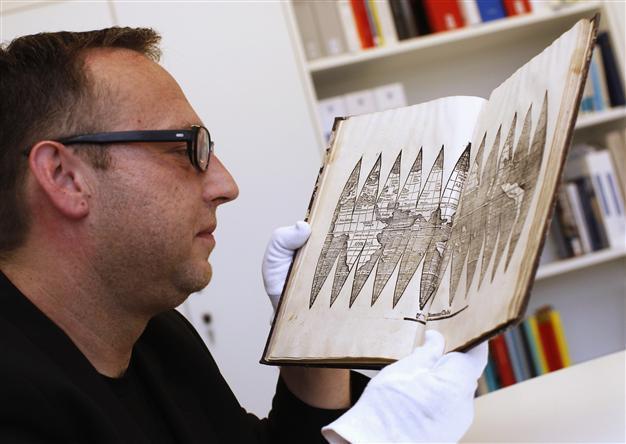Version of 'America's birth certificate' surfaces in Germany
BERLIN - Agence France-Presse

Sven Kuttner, head of the library district Alte Buecher (old books), looks at a famous cartography after its discovery in Munich's university library July 3, 2012. The cartography is believed to be the fifth existing version of a map by Martin Waldseemuller (around 1470-1522). The Munich exemplar could be developed shortly after the first print of 1507 in Alsatia. REUTERS/Michaela Rehle
Librarians at a German university have stumbled across a version of the 500-year-old world map that was the first to mention the name "America", they said, calling the chance find "sensational".Experts did not even know about the existence of a fifth copy of the map by German cartographer Martin Waldseemueller until it showed up a few days ago, Ludwig Maximilian University of Munich said.
The discovery is much smaller and thought to have been made after the 1507 original version, which Germany officially handed over to the United States in 2007 and now lies in the Library of Congress in Washington.
The newly unearthed map, one of the so-called globe segments, is believed to have been produced by Waldseemueller himself, who died in 1522.
These were "at least as important for the dissemination of geographical knowledge in his own time" as the three-square-metre world wall map, which is UNESCO-registered and often dubbed "America's birth certificate", the university said. The new find shows the world divided into twelve segments which taper to a point at each end and are printed on a single sheet, which, when folded out, form a small globe, with the three rightmost segments depicting a boomerang-shaped territory named America.
Only four copies of the segmental maps were previously known about, the university said in a written statement.
One of the four was sold at auction for one million dollars in 2005.
The fifth was found by a bibliographer, who was revising the catalogue, "in an otherwise unremarkable volume that had been rebound in the 19th century", it said.
It was nestled between two printed works on geometry from the early 16th century.
"Even in our digital age the originals have lost none of their significance and unique fascination," Klaus-Rainer Brintzinger, the head of the library, said in the statement.
"We intend to make the map accessible to the public in digital form in time for the Fourth of July, Independence Day in the USA," he added.
The unearthed map managed to survive World War II, hidden but unscathed, despite air raids having devastated the university library as much of its holdings of older books were moved out in 1942.
Waldseemueller probably used information gleaned from the transatlantic voyages of Christopher Columbus, Amerigo Vespucci -- after whom America is named -- and unknown Portuguese and Spanish sources, to draw the 1507 map.
Historians ponder why he named the new continent after Vespucci and not Columbus, who 'discovered' America in 1492.
















